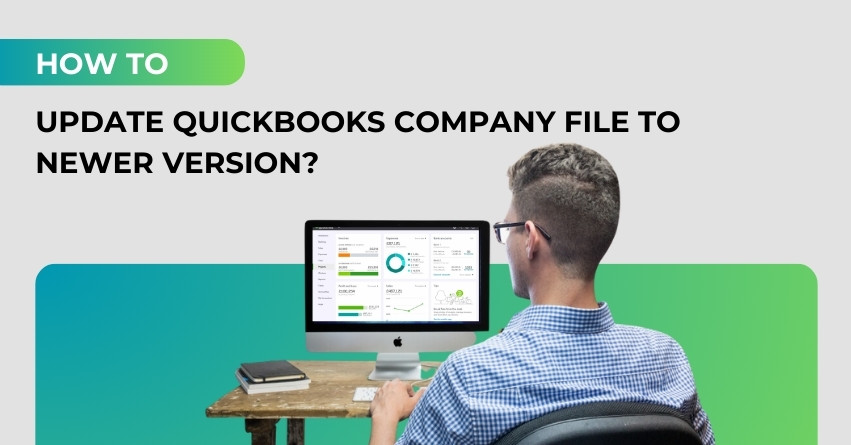QuickBooks helps businesses manage their financial transactions efficiently. To ensure you have access to the latest features and improvements, it’s essential to keep your QuickBooks company file updated to the newest version. In this comprehensive article, we will walk you through the step-by-step process of updating your QuickBooks company file to QuickBooks 2023. Whether you’re new to QuickBooks or an experienced user, these instructions will help you seamlessly transition to the latest version.
Solutions to Update Your QuickBooks Company File
Step 1: Backup Your Company File
Before performing any major updates, it’s essential to back up your QuickBooks company file. This precautionary measure ensures that you can restore your data in case anything goes wrong during the update process.
To back up your company file:
- Open QuickBooks and log in to your company file.
- Click on “File” in the top menu bar.
- Select “Create Backup.”
- Follow the on-screen instructions to create a backup of your company file. Save it to a safe location on your computer or an external storage device.
Step 2: Check for Compatibility
Before updating to QuickBooks 2023, it’s crucial to verify that your system meets the software’s requirements. QuickBooks may not work correctly on outdated hardware or operating systems. Ensure that your computer meets the following minimum requirements:
- Operating System: Windows 10 or macOS 10.14 (Mojave)
- Processor: 2.4 GHz minimum
- RAM: 4 GB minimum (8 GB recommended)
- Disk Space: 2.5 GB of disk space
- Internet Connection: A high-speed internet connection is recommended for software downloads and updates.
If your system meets these requirements, you can proceed with the update. If not, you may need to upgrade your hardware or operating system before updating QuickBooks.
Step 3: Download the Latest QuickBooks Version
To update your QuickBooks company file to QuickBooks 2023, you’ll need to download the latest version of QuickBooks. Follow these steps:
- Open QuickBooks and log in to your company file.
- Click on “Help” in the top menu bar.
- Select “Update QuickBooks.”
- Go to the “Update Now” tab.
QuickBooks will check for updates and provide you with the option to update to the latest version. Click “Get Updates” to start downloading the update.
Step 4: Install the Update
Once the update is downloaded, follow these steps to install it:
- Close QuickBooks to ensure that no files are in use during the installation.
- Locate the downloaded update file (usually in your Downloads folder) and double-click on it to run the installer.
- Follow the on-screen instructions to complete the installation. This may include accepting the license agreement and choosing the installation location.
Once the installation is complete, QuickBooks will prompt you to open your company file. At this point, do not open your company file directly. Instead, follow the next step to update your company file to the new version.
Step 5: Update Your Company File
Updating your QuickBooks company file is a crucial step in the process. Here’s how to do it:
- Open QuickBooks but do not open your company file yet.
- Go to the “File” menu in QuickBooks.
- Select “Open or Restore Company.”
- Choose “Open a company file” and click “Next.”
- Browse to the location where your company file is stored. Select the file with the .QBW extension (your company file) and click “Open.”
- QuickBooks will display a message that says, “This company file needs to be updated to work with this version of QuickBooks.” Click “Update Now” to start the update process.
- Follow the on-screen instructions to complete the update. QuickBooks will create a backup of your old company file and convert it to the new version. This process may take some time, depending on the size of your company file.
- Once the update is complete, QuickBooks will open your company file in the new version.
Step 6: Verify and Reconcile Your Data
After updating your company file, it’s essential to verify and reconcile your data to ensure accuracy. Here’s what to do:
- Check your account balances, transactions, and reports to ensure that everything transferred correctly during the update.
- Reconcile your bank and credit card accounts to make sure they match your actual statements.
- Review your customer and vendor information to confirm that it’s up to date.
- Run a test payroll to ensure that all employee data and tax information is accurate.
If you discover any discrepancies or issues, address them promptly to prevent accounting errors down the line.
Step 7: Update QuickBooks Add-ons and Integrations
If you use any third-party add-ons or integrations with QuickBooks, it’s essential to ensure that they are compatible with the new version. Some add-ons may require updates to work correctly with the latest QuickBooks release. Visit the websites of your add-on providers or contact their support teams to inquire about compatibility and updates.
Step 8: Train Your Team
If you have a team of users who access your QuickBooks company file, it’s essential to provide them with training on the new features and changes introduced in QuickBooks 2023. This training will help your team make the most of the updated software and ensure that everyone is on the same page regarding its functionality.
Step 9: Regularly Backup Your Company File
After updating your QuickBooks company file, it’s crucial to maintain a regular backup schedule. Set up automatic backups within QuickBooks to ensure that your data is consistently protected. Regular backups are essential for data security and recovery in case of unforeseen issues.
Step 10: Keep Your QuickBooks Updated
QuickBooks regularly releases updates and patches to fix bugs, improve stability, and address security issues. To ensure your software remains secure and up to date, set up automatic updates within QuickBooks. This will help you stay current without having to manually check for updates.
Why Should You Update Your QuickBooks Company File?
Before we delve into the update process, let’s understand why it’s crucial to keep your QuickBooks company file up to date:
1. Access to New Features:
QuickBooks regularly releases updates with new features, enhancements, and bug fixes. By updating your company file, you can take advantage of these improvements, which can boost your productivity and streamline your accounting processes.
2. Compliance with Tax Laws:
Tax regulations are constantly changing. Using an outdated QuickBooks version may result in errors in your tax calculations and filings. Keeping your software current ensures you remain compliant with the latest tax laws.
3. Enhanced Security:
Software developers release updates to address security vulnerabilities. Updating QuickBooks ensures that you have the latest security patches, protecting your financial data from potential threats.
4. Improved Stability:
Newer versions of QuickBooks are often more stable and reliable than older ones. Updating your company file can prevent unexpected crashes and data corruption issues.
5. Better Support:
If you encounter problems while using QuickBooks, the support team is more likely to assist you if you’re using the latest version. They may not provide support for outdated software.
Conclusion
Updating your QuickBooks company file to a newer version, such as QuickBooks 2023, is a critical step in maintaining accurate financial records and staying compliant with tax regulations. By following the steps outlined in this guide, you can ensure a smooth transition to the latest QuickBooks release while safeguarding your financial data and taking advantage of new features and improvements. Remember to regularly back up your company file, keep your software and add-ons updated, and provide training to your team to maximize the benefits of the updated QuickBooks version. With these practices in place, you can effectively manage your finances and keep your business running smoothly.
Frequently Asked Questions
Updating your QuickBooks company file to a newer version is essential for several reasons. It gives you access to new features, ensures compliance with changing tax laws, enhances security, improves software stability, and allows for better support from QuickBooks if you encounter issues.
No, you cannot update your company file directly within QuickBooks. You need to install the newer version of QuickBooks first and then use the software to update your company file to the new version.
To back up your company file, open QuickBooks, click on “File,” select “Create Backup,” and follow the on-screen instructions. Save the backup file to a secure location on your computer or an external storage device.
The minimum system requirements for QuickBooks 2023 are:
Operating System: Windows 10 or macOS 10.14 (Mojave)
Processor: 2.4 GHz minimum
RAM: 4 GB minimum (8 GB recommended)
Disk Space: 2.5 GB of disk space
Internet Connection: A high-speed internet connection is recommended for software downloads and updates.
Ensure your system meets these requirements before updating.
To download the latest QuickBooks version, open QuickBooks, click on “Help,” select “Update QuickBooks,” and go to the “Update Now” tab. QuickBooks will check for updates and provide an option to download the latest version. Click “Get Updates” to start the download.
Yes, you can update QuickBooks even if your company file is hosted on a network. However, it’s essential to ensure that all users on the network are on the same version of QuickBooks to prevent compatibility issues.
If you encounter errors during the update process, first, ensure that your system meets the minimum requirements for the new version. If the issue persists, contact QuickBooks support for assistance. It’s crucial to resolve any errors promptly to avoid data corruption.
Yes, it’s recommended to check the compatibility of your QuickBooks add-ons and integrations with the new version. Some add-ons may require updates to work correctly. Contact the providers of your add-ons or integrations to inquire about compatibility and updates.
After updating your company file, establish a regular backup schedule within QuickBooks. Automatic backups are recommended to ensure that your data is consistently protected. Regular backups are essential for data security and recovery in case of unforeseen issues.
Once you update your company file to a newer version, it’s challenging to revert to a previous version. It’s advisable to backup your company file before updating, so you have a copy of the old version in case you encounter issues and need to restore it. However, restoring older backups may result in data loss for transactions made after the update.
Yes, it’s essential to provide training to your team on the new QuickBooks version, especially if there are significant changes or new features. Training ensures that your team can effectively use the updated software, which can improve efficiency and accuracy in your accounting processes.








